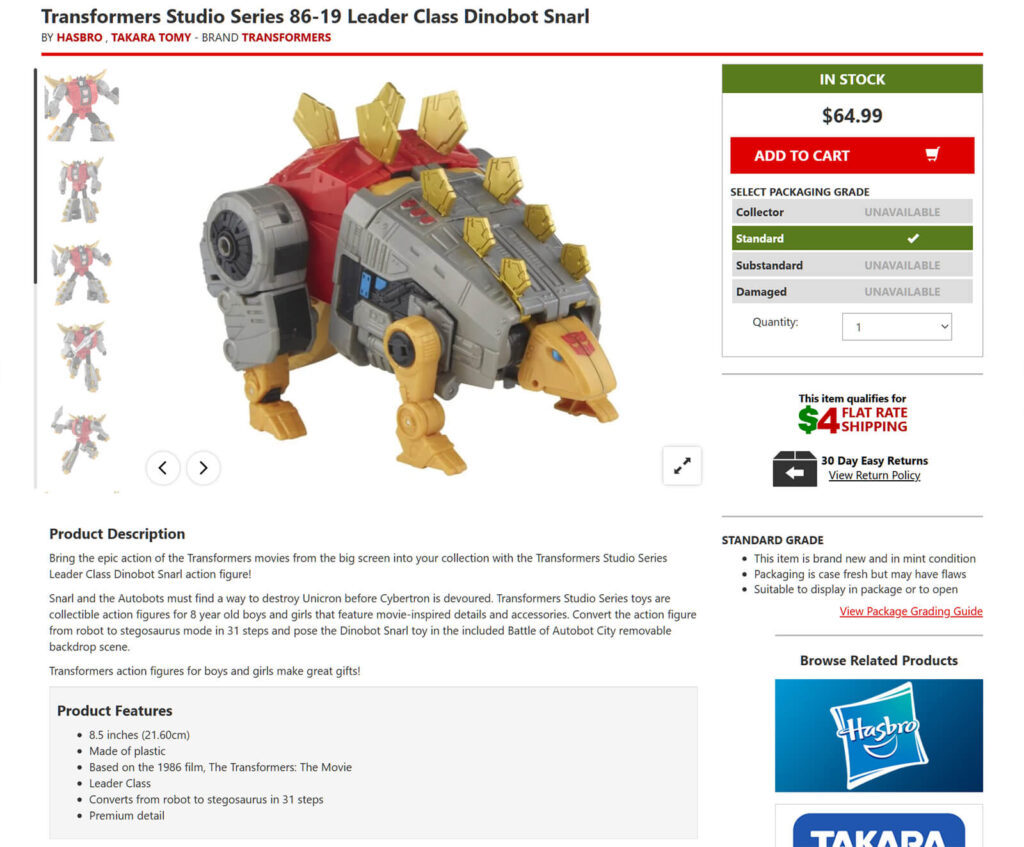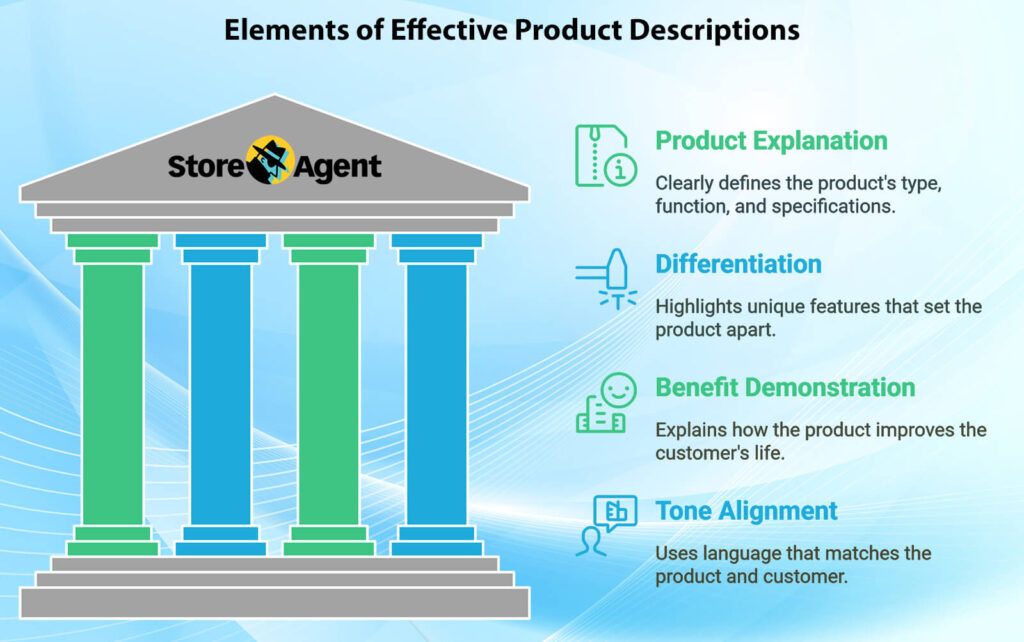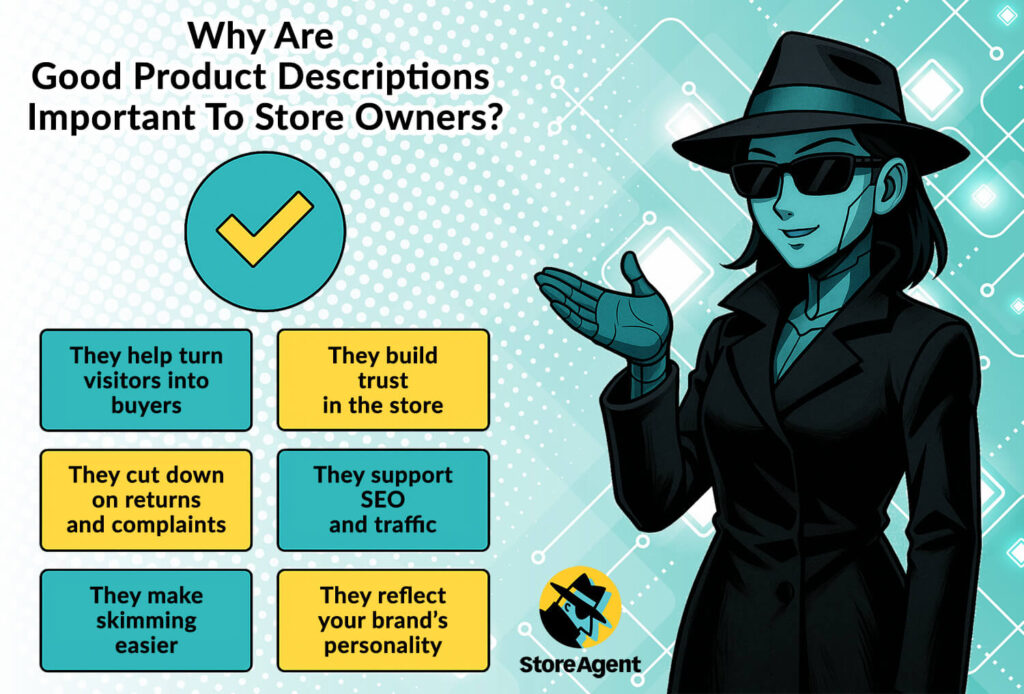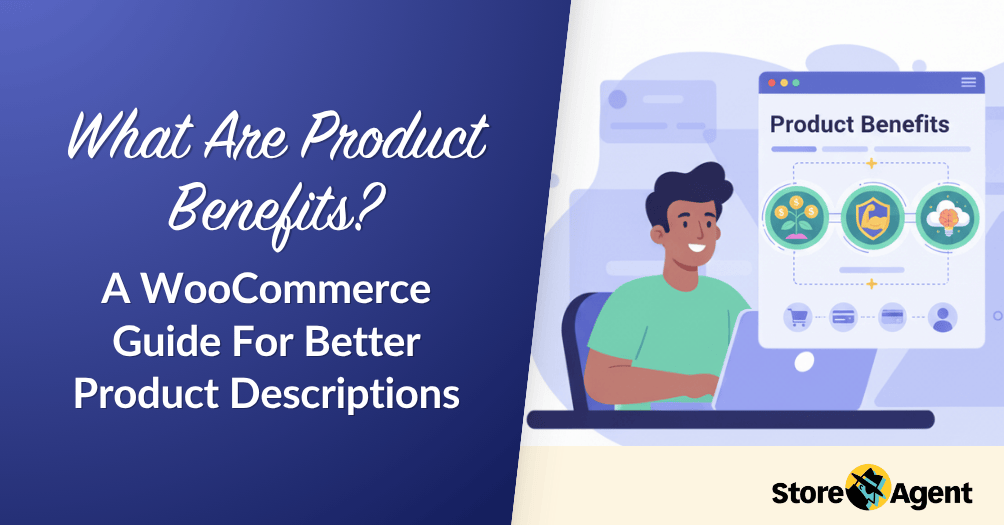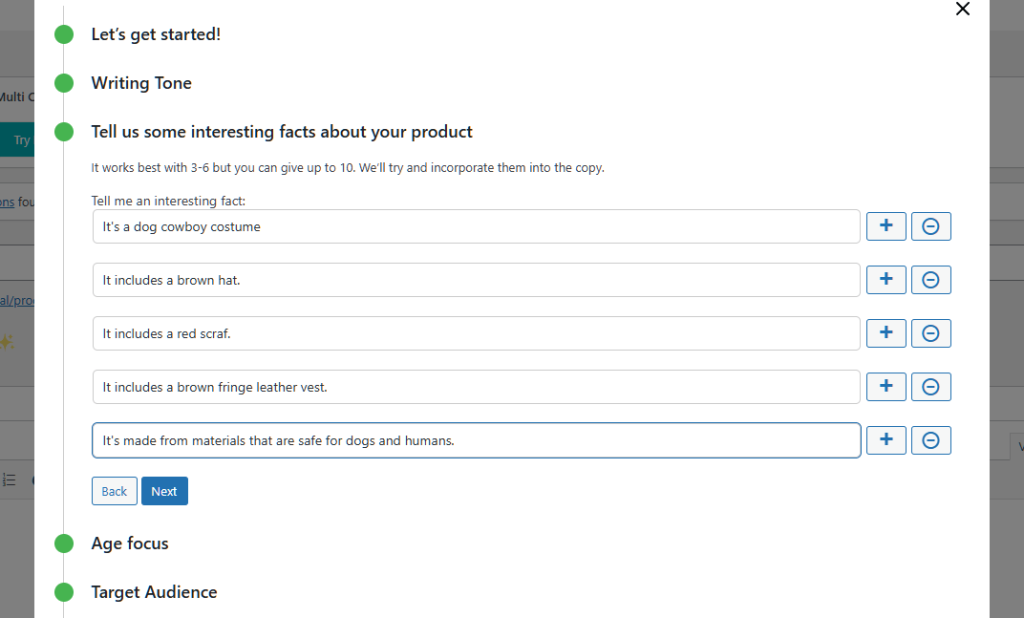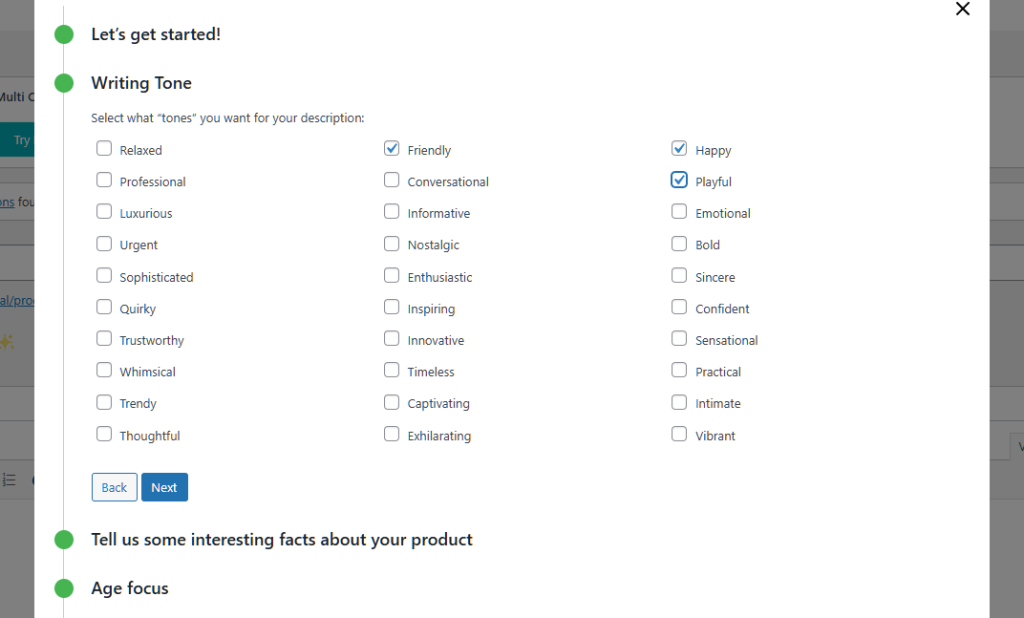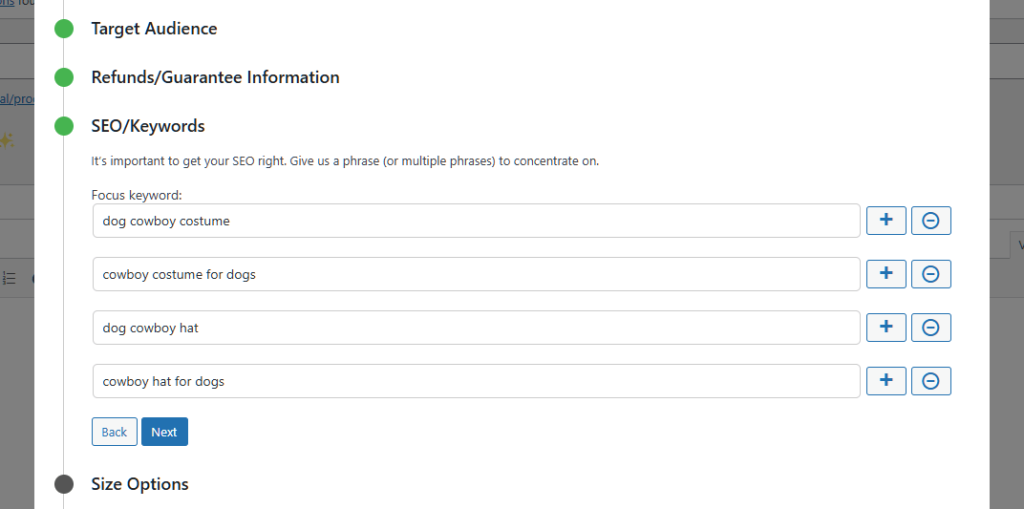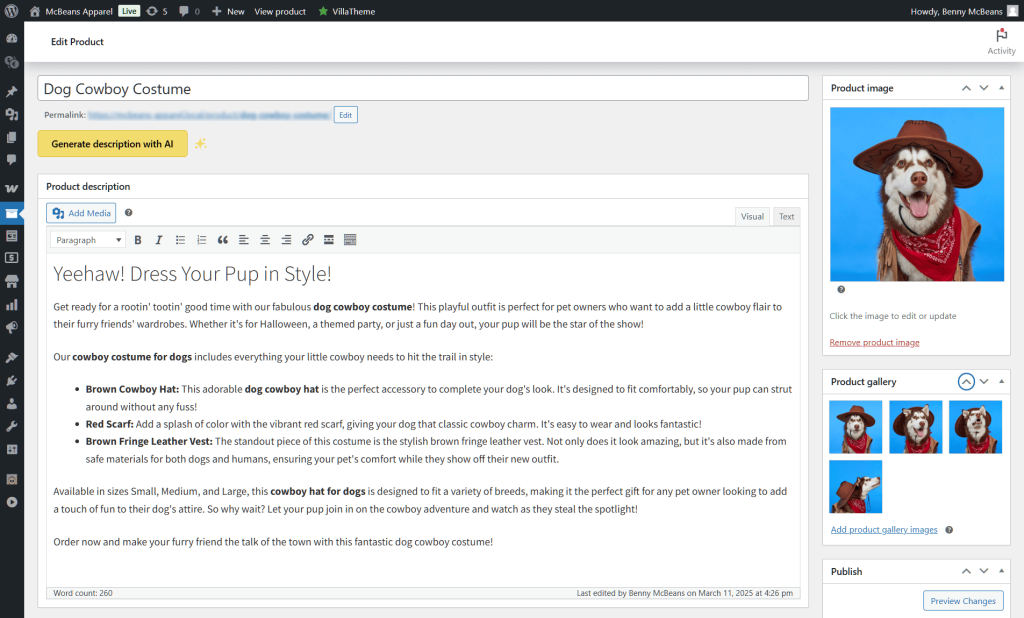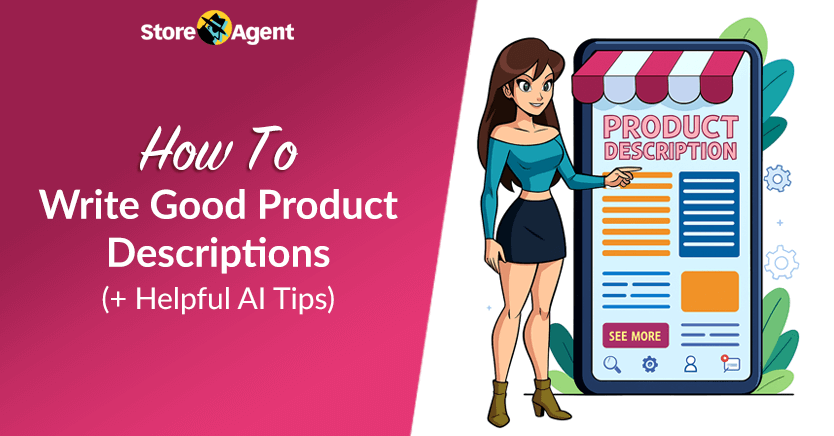
From experience, we know how hard it is to get a shopper’s attention. Keeping that attention long enough to make a purchase is even harder. This is where good product descriptions can help.
An ecommerce product description can make the difference between a sale and an abandoned cart. A good one doesn’t just describe. It connects. Like a friendly shopkeeper who knows just what to say, it helps the customer picture the product in their life.
In this article, we’ll share tips for writing better descriptions using plain language, real benefits, and the right keywords. We’ll also show how WooCommerce AI can help speed things up while keeping the quality strong.
So read on!
- I. What Is A Product Description?
- II. Why Are Good Product Descriptions Important To Store Owners?
- III. Tips On How To Write Good Product Descriptions
- IV. How AI Makes Crafting Good Product Descriptions Easier
- Conclusion
- Frequently Asked Questions
I. What Is A Product Description?
A product description is a short piece of text that explains what the product is. It usually includes its features, size, materials, and other helpful details.
Every online store needs great product descriptions. Without them, even the best items can sit on the shelf, ignored.
But a good product description does more than just list facts. It speaks to the reader like a store clerk would. It answers the shopper’s frequently asked questions before they ask. In addition, it shows why the product matters and how it fits into their life.
What makes a good product description?
Writing a great product description is a mix of clear writing, smart choices, and customer understanding. Like a recipe, you need the right ingredients to get the best result.
With that in mind, a good product description:
1. Explains what the product is: A product description should cover the basics. This includes the product type, what it does, and any important specs like size, material, or colors.
2. Highlights what makes it different: If the product has special features, they should be easy to spot. Whether it’s handmade, eco-friendly, or only available for a short time, the reader should know what sets it apart.
3. Shows how the product helps: A good description doesn’t just say what the product does. It says why it matters. For example, “insulated” means more than a feature—it means hot drinks stay warm longer.
4. Speaks in the right tone: The language should match the product and the customer. A toy might call for playful words. A kitchen knife might need a more practical tone. Either way, the goal is to sound real, not robotic.
In short, a good product description gives readers the facts, the feeling, and the reason to click “add to cart.” That’s what makes it work.
II. Why Are Good Product Descriptions Important To Store Owners?
According to Forbes, 70% of online shoppers say product content, which includes product descriptions, is the deciding factor in a purchase. Meanwhile, as many as 70% of consumers leave a product page when the information is unclear or incomplete.
Simply put, good product descriptions help online stores sell more. They don’t just fill space; they guide shoppers.
In a physical store, people can touch and test items. Online, they only have pictures and words. A good description fills that gap like a helpful salesperson would.
From what we’ve seen, here are some of the ways good descriptions help store owners:
1. They help turn visitors into buyers: Clear descriptions give shoppers the answers they need. This can be the final push to complete the purchase.
2. They cut down on returns and complaints: When people understand exactly what they’re buying, they’re less likely to feel misled or confused.
3. They build trust in the store: Good writing shows care. It makes the whole shop feel more dependable.
4. They support SEO and traffic: Using the right words helps your product appear in search results. That means more potential buyers without needing ads.
5. They reflect your brand’s personality: A well-written description shows off the tone and voice of your store. Whether it’s playful, calm, or professional, it helps shoppers get a feel for who you are.
6. They make skimming easier: Most people don’t read every word. A clear layout with short sentences or bullet points helps shoppers spot what matters fast.
Strong product descriptions don’t just boost sales. They help people feel good about their choices and make your store feel like a place they can trust.
III. Tips On How To Write Good Product Descriptions
Great product descriptions aren’t just written. They’re built with care.
Below are a few simple tips to help make yours clearer, stronger, and more likely to convert.
1. Know your audience
Knowing your target audience is the first step to writing good product descriptions. The tone, language, and details should match what they care about most.
When a shopper reads a product page, they should feel like it was written just for them. That only happens when you understand who they are and what they value.
- Match their tone and language: If your buyers are casual and fun, your writing should sound that way too. If they’re more serious or practical, keep the tone clear and no-nonsense.
- Highlight what matters to them: Choose details they actually care about. A pet owner wants comfort and cuteness. A tech buyer might care more about specs or performance.
- Use examples that feel familiar: Let’s say you’re selling a pet-themed blanket. You could write: “This cozy blanket features cute paw prints and soft fabric, perfect for snuggling with your furry friend. It’s designed to keep both pets and pet lovers comfortable during chilly nights or lazy afternoons.” This speaks directly to pet lovers and shows the product in their daily life.
Understanding your product target market is key to crafting descriptions that truly resonate. When you know who your buyers are and what matters most to them, your product pages speak directly to their needs and motivations, boosting connection and conversions.
2. Use the words your customers use
Good product descriptions use the same words your customers are already thinking. These are called keywords.
Keywords are the terms people type into search bars. They’re how shoppers look for products online. If your product page includes those same words, it’s easier for them to find it.
But keywords aren’t just for search engines. They help your product feel familiar and relatable. Like using the same slang as your group of friends, the right words make people feel understood.
Here are some tips on getting your keywords right:
- Know what people search for: Think about what your customer might type when looking for your product. If you’re selling hiking boots, “waterproof hiking boots for men” might work better than just “boots.” Use specific words, not just broad ones.
- Use tools to find keywords: You don’t have to guess. Tools like Keywords Everywhere or Ubersuggest show you real search terms and how often they’re used. Some even show you similar phrases that people also type.
- Add them naturally: Once you have your keywords, place them in your title, product description, and tags. But keep it sounding natural. If the writing feels forced or stiff, it can turn people away.
Using your customer’s own words helps them feel like the product was made for them. It also makes your listing easier to find. It’s a small change that can bring big results.
Keywords and search engine optimization are a big part of writing great product descriptions. In fact, they’re so important that we made a separate guide just for them. Check it out here:
SEO Product Descriptions: How To Write Them And Speed Up The Process With AI
3. Say what the product does, not just what it is
Good product descriptions don’t stop at listing facts. They explain how those facts matter to the person reading. In other words, a good description lists the product’s benefits, not just its features.
Most shoppers don’t care about a product’s technical details right away. What they really want to know is, “What does this do for me?” A strong description answers that without making them think too hard.
Features tell what a product has. Benefits explain why that feature makes life better. Like explaining not just what’s in the toolbox, but how it helps fix the sink.
Here are some tips on writing descriptions that state the product benefits:
- Focus on the customer’s gain: Instead of only saying “made with stainless steel,” say what that means. For example: “keeps your drink cold for 24 hours, so you can stay refreshed on long hikes.” That’s what people remember.
- Turn each feature into a small story: Think of the feature as the setup and the benefit as the result. “Soft memory foam” becomes “cushions your feet all day, even on long walks.” Try to paint a small picture of what it feels like to use the product.
- Look at reviews for clues: Real customers often say why they like the product in their own words. Use those insights to shape your benefits. If people say, “This tote fits everything without being bulky,” that’s a benefit worth using.
Features can help, but benefits connect. When people see how a product fits into their daily life, they’re more likely to trust it and buy it.
4. Keep descriptions clear, not clever
Good product descriptions are easy to understand. That’s what helps people decide if the item is right for them.
It’s tempting to sound fancy or clever. But most of the time, plain language works better. Shoppers aren’t here for a puzzle. They want answers, fast.
Simple words don’t mean boring. They mean clear. Like a clean window, they let people see exactly what they’re getting.
- Say it like you mean it: Skip the slogans and write like you talk. Instead of saying “unleash your potential,” say “great for long runs and daily walks.” If a 12-year-old can understand it, you’re on the right track.
- Use everyday language: Pick words your customers actually use. Say “waterproof” instead of “moisture-repellent.” Say “soft and stretchy” instead of “engineered textile flexibility.”
- Let the product do the talking: If the item has strong features, don’t bury them in wordplay. Just explain what they do. For example, “machine-washable” speaks louder than “no-fuss maintenance solution.”
Good writing helps people focus on the product, not the sentence. When it’s easy to understand, it’s easier to buy.
However, keep in mind that your tone should match your target audience. If you’re selling to people who appreciate a bit of flair and creativity, feel free to get more expressive with your language.
For example, when selling a superhero action figure, you could say, “Step into the shoes of your favorite hero with this limited-edition action figure, complete with epic details and full articulation, all packed into 7 inches of heroic power.”
5. Build an emotional connection
Great product descriptions do more than share facts. They help shoppers feel something.
That emotional connection might be comfort, excitement, pride, or peace of mind. The goal is to show how the product fits into real moments. Like how a cozy blanket turns a rainy day into something warm and calming.
Here’s how to write with feeling:
- Make it relatable: Think about when someone would actually use the product. A mug isn’t just ceramic; it’s part of a quiet morning or a gift for someone they love.
- Use sensory words: Words like soft, smooth, crisp, or warm help people imagine the product in their hands. These little details spark emotion and memory.
- Tap into values: Some shoppers care about how things are made. Whether it’s handmade, eco-friendly, or supports a small business, these points help build a stronger emotional connection.
When readers feel something, they stop scrolling. A strong emotional connection can turn interest into trust, and trust into a sale.
6. Use bullet points when it makes sense
Good product descriptions don’t always need to be long. Sometimes, shoppers just want to scan and get the facts fast.
Most people don’t read every word. They skim. This means big blocks of text can slow them down or make them leave the page.
Bullet points help solve that. They highlight important details quickly. Like road signs on a busy street, they guide people to what they need.
- People scan, not study: Shoppers are usually in a hurry. They’re comparing products or checking for one key feature. Bullet points let them grab the info they need without digging.
- Use bullets for fast facts: Specs, materials, sizes, and product options are easier to follow in a list. It saves the shopper time. It also helps reduce questions about the product later.
- Keep the layout balanced: Start with a short intro, then use bullets for the key points. This keeps the page clean but still gives enough information to help someone decide.
Here’s how you might write bullets for a 3D-printed puppy statue:
- Hand-painted, with lifelike details and texture
- Printed in durable resin for long-lasting display
- Stands at 5 inches tall, perfect for desks or shelves
- Choose from a Siberian Husky, Golden Retriever, or German Shepherd
This format shows the key facts at a glance, without overloading the reader.
Remember, bullet points make descriptions scannable and product pages easier to use. They keep readers moving, help them feel informed, and bring the most important details to the front.

IV. How AI Makes Crafting Good Product Descriptions Easier
Good product descriptions take time and effort. But writing them all manually for dozens or even hundreds of products can wear you out fast.
That’s where AI tools can help. They speed up the writing while keeping your descriptions clear, focused, and readable.
1. Learn the rules of writing good product descriptions before using AI
AI works best when you know what makes a good description in the first place. Think of AI like a kitchen assistant. It can prep the ingredients and even cook the meal for you. But you still need to know the basics of what makes a good meal.
After all, while AI tools are fast, they still need direction. If you don’t know what a good description looks like, you might accept whatever the tool gives you, even if it’s vague or full of fluff.
When you know the fundamentals of good product descriptions, you can guide the AI. You’ll know the importance of writing with a specific audience in mind, incorporating relevant keywords, and highlighting benefits. That’s how you get useful results instead of just “fast” ones.
2. What a product description AI tool does
A good product description AI tool writes descriptions for you based on your product details. It also takes what you know about good product descriptions and turns that knowledge into better, more accurate content that fits your brand and audience.
StoreAgent, a collection of AI tools built for WooCommerce store owners, includes a tool called Product Description AI. It does everything we just mentioned, and it’s made to fit right into your workflow. Currently, it’s one of the best product description generator for e-commerce.
Here’s how it works at a glance.
First, you supply it with details like the product’s name, age focus, and audience.
For example, in the image below, we provide the AI with the product’s unique features. To add another unique selling proposition, we simply have to click the + button.
You can also pick a writing tone that fits your brand. Whether it’s fun, casual, or direct, the tool adjusts the writing style to match.
You can even have the AI include keywords in the description.
Once you’re done, the AI turns the information you provided into a clear and compelling product description that sounds natural.
You can edit this description anytime you wish. Alternatively, you can have the AI write a product description again from scratch.
Interested to know more about StoreAgent’s Product Descriptions AI? Then read the following extensive guide:
WooCommerce AI Product Description Tool: How To Automate Your Product Copy
3. How AI saves time and keeps your product listings strong
Instead of writing everything from scratch, AI starts with a full draft in seconds. This helps you move faster, especially when you have lots of items.
As shown above, you still get control over what the description says. Edit it, adjust the tone, or swap out a line. You’re not locked in.
Using AI isn’t about skipping the work. It’s about speeding it up without losing quality. When you know what to look for, tools like StoreAgent help you write better descriptions faster and easier.
Conclusion
Writing great product descriptions takes more than filling in a few lines. It’s about understanding your audience, choosing the right words, and showing why your product matters. Each sentence should work like a friendly guide, helping shoppers feel confident about what they’re buying.
The good news? You don’t have to do it all alone. Once you know the basics, tools like StoreAgent can help you write product descriptions that sell quickly, clearly, and with your brand’s voice in mind.
To recap, this article covered the following core ideas about how to write great product descriptions:
- What is a product description?
- Why are good product descriptions crucial for your ecommerce business?
- Tips on how to write product descriptions that convert
- How AI makes crafting good product descriptions easier
Remember, when you optimize product descriptions, you build trust, reduce returns, and get more people to hit “add to cart.” That’s a win for you and your customers.
Curious about writing better product descriptions and using AI to help? Then check out StoreAgent, the smart tool for WooCommerce sellers!
Frequently Asked Questions
What applications can automate product content creation?
For WooCommerce, a strong option in automating product content creation is StoreAgent’s AI Product Description Assistant Tool. It works directly inside WordPress and automatically generates optimized copy for your product listings. You can set the tone, add key facts, include SEO keywords, and adjust length. Then insert the content into your product fields with one click. This saves time, improves consistency, and helps products rank better in search results.
How long should a product description be for SEO?
For most SKUs, 120–300 words works well. Complex or high-ticket items can go 300–500 words, with a 1–2 sentence summary and 4–6 scannable bullets.
What’s the best structure for a high-converting product description?
Lead with a value statement, add benefit-focused bullets, include specs/size/fit, and finish with shipping/returns and a micro-FAQ. Keep paragraphs short for mobile.
Where do keywords go on a WooCommerce product page?
Prioritize the product title, short description, H2/H3 subheads, main description, attributes, image alt text, and meta title/description. Avoid keyword stuffing.
How often should I update product descriptions?
Review quarterly or whenever specs, pricing, or seasonality change. Watch PDP conversion, returns, site-search queries, and chat logs to spot gaps that need fixes.
